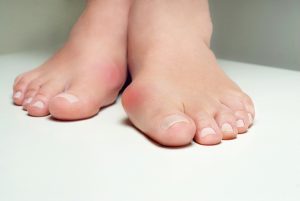How to Relieve Bunion Pain
 What are bunions?
What are bunions?
A bunion is a bony bump of the big toe joint on your foot – the metatarsophalangeal (MTP) joint. Bunions can be very painful and develop over time due to pressure on this joint changing its structure. The deformity tends to increase gradually, making it painful to wear shoes or walk.
Hallux valgus can be associated with a bunion which is the big toe turning toward the 2nd toe.
Who can get a bunion?
Anyone can get a bunion, but bunions are typically more problematic with women and older individuals than men or younger people.
How do I know if I have a bunion?
The most obvious signs of a bunion are a bump on the side of your big toe or your big toe turned inward, pressing against the others. You may also see redness and experience pain in your big toe joint area due to a growing bunion irritated by footwear.
It’s also important to remember that bunions start small and grow slowly, so look for hardened skin or a callus on the side of the foot and tenderness or pain at the base of the foot’s big toe and ball area.
What Causes Bunions?
Bunions are hereditary and can be seen in both men and women. Women seem to have more problems with bunions because women’s shoes seem to be tighter and make bunions more symptomatic.
Bunions are usually related to certain foot types. Children can have bunions but this is rare.
Treating Bunions
There are a couple of ways to treat bunions depending upon how problematic they are for you. You can opt for a non-surgical remedy, or your doctor may recommend surgery.
Some non-surgical remedies include:
- Wearing shoes that are roomy in the toe box (choose shoes based on comfort instead of size)
- Over-the-counter, non-medicated bunion pads or cushions to create a barrier between your shoe and your foot.
- Icing your bunion to relieve soreness or swelling after being on your feet for long periods.
- Shoe inserts to distribute the pressure evenly throughout your shoe to prevent the bunion from worsening.
- Anti-inflammatory medications such as ibuprofen or naproxen can temporarily relieve pain and reduce swelling.
When Should I have surgery for my bunions?
If you have difficulty walking or the pain is unmanageable, your doctor may recommend surgery. There are several surgical procedures to correct bunions with same-day options that don’t require a hospital stay.
There are many types of bunion surgery and depending on the deformity the doctor would discuss the best procedure for your bunion.
Lapiplasty® 3D Bunion Correction is a new, patented treatment for bunion correction. It’s a new treatment option that does more than removing “the bump.” It addresses your bunion in three dimensions to correct the problem at its root.
Lapiplasty® 3D Bunion Correction uses advanced fixation technology to secure the correction in place, allowing patients to walk within days of surgery. You’ll be able to walk in a surgical boot in a few days instead of 6-8 weeks and get back to a better quality of life faster.
We specialize in the following
- Arch pain
- Arthritis
- Bunions
- Corns and Calluses
- Custom foot orthodics
- Diabetic foot care
- Flat feet
- Forefoot pain
- Fractures
- Sprains and strains
- Hammertoes
- Heel Toes
- Infection/Wounds
- Nail fungus
- Sports injuries
- Warts